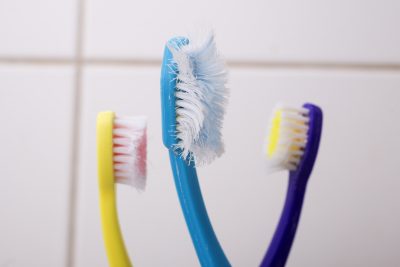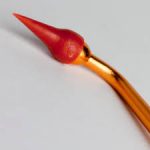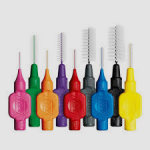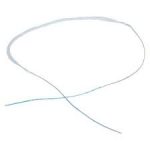Tooth brushing will remove dental plaque and other debris from your teeth. Plaque plays a primary role in oral disease such as tooth decay and gum disease. The best way to remove plaque from the tooth surface on a daily home care basis is through tooth brushing. Use a soft bristled brush (synthetic bristles preferably because natural bristles tend to harbor the oral bacteria as the bristles are more porous). Be sure it is the right size.
Place the bristles at a 45 degree angle to the teeth. Slide the tips of the brush under the gums. Jiggle the bristles very gently so that any plaque growing under the gum will be removed. Be sure to brush the outside, the tongue side and the chewing surfaces of your teeth. For the front teeth, brush the inside surfaces of the upper and lower jaws by tilting the brush vertically and making several up and down strokes with the front part of the brush over the teeth and gum tissues.
![teeth_brushing[1]](https://lemesosdental.com/wp-content/uploads/2018/11/teeth_brushing1-400x267.jpg)
![1_4F82BSp_UzePOXNu_ACu4g[1] 1_4F82BSp_UzePOXNu_ACu4g[1]](https://lemesosdental.com/wp-content/uploads/2018/11/1_4F82BSp_UzePOXNu_ACu4g1-400x267.jpeg)
Brushing your tongue will help freshen your breath. Debris and bacteria can collect on your tongue and cause bad breath.
To prevent plaque damage, be sure to brush at least once every day, preferably at bedtime. Adding a brush time after breakfast increases your chances of thorough daily plaque removal.
Don’t rush your brush. A thorough brushing should take at least 3 minutes.
Brushing the teeth too vigorously or using a hard bristled toothbrush causes the gums to recede and exposes root surfaces. It also wears down the tooth structure. Both of these conditions can lead to tooth sensitivity.
Replace your brush when the bristles begin to spread. A worn out toothbrush will not properly clean your teeth.

 Gum stimulator — for massaging gums and firming up problem areas after surgery, not to be used on healthy tissues
Gum stimulator — for massaging gums and firming up problem areas after surgery, not to be used on healthy tissues
 Interdental brushes (foam or bristles) — for cleaning spaces between teeth or underneath bridges
Interdental brushes (foam or bristles) — for cleaning spaces between teeth or underneath bridges
 Special floss — for cleaning difficult areas like under bridges or braces
Special floss — for cleaning difficult areas like under bridges or braces
 Orthodontic toothbrush — special v-trimmed bristles designed to effectively clean around braces
Orthodontic toothbrush — special v-trimmed bristles designed to effectively clean around braces
What Type of Toothbrush Should I Use?
Most dental professionals agree that a soft-bristled brush is best for removing plaque and debris from your teeth. Small-headed brushes are also preferable, since they can better reach all areas of the mouth, including hard-to-reach back teeth. For many, a powered toothbrush is a good alternative. It can do a better job of cleaning teeth, particularly for those who have difficulty brushing or who have limited manual dexterity.
How important is the Toothpaste I Use?
It is important that you use a toothpaste that’s right for you. Today there is a wide variety of toothpaste designed for many conditions, including cavities, gingivitis, tartar, stained teeth and sensitivity.
Ask your dentist which toothpaste is right for you.
 English
English Ελληνικά
Ελληνικά Русский
Русский